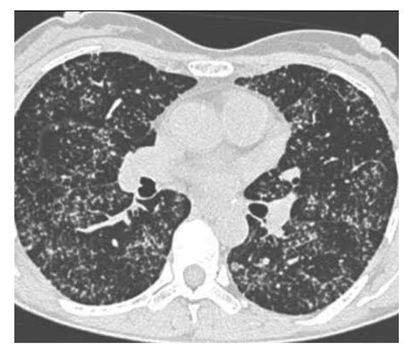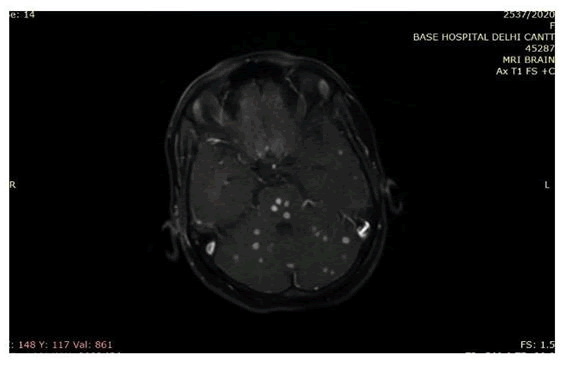Short Communication - (2024) Volume 8, Issue 1
Disseminated Miliary Tuberculosis
Rahul Soni1* and
Jayita Debnath2
1Department of Neurology, All India Institute of Medical Sciences University, Bhopal, India
2Department of Clinical Biochemistry, Durgapur Institute Science and Technology, West Bengal, India
*Correspondence:
Rahul Soni, Department of Neurology, All India Institute of Medical Sciences University, Bhopal,
India,
Email:
Received: 29-Mar-2022, Manuscript No. IPJCGH-23-12798;
Editor assigned: 01-Apr-2022, Pre QC No. IPJCGH-23-12798 (PQ);
Reviewed: 15-Apr-2022, QC No. IPJCGH-23-12798;
Revised: 02-Jan-2023, Manuscript No. IPJCGH-23-12798 (R);
Published:
30-Jan-2023, DOI: 10.36648/2575-7733.8.1.06
Introduction
Disseminated miliary tuberculosis is one of the rarest forms of
Tuberculosis (TB) seen in immunecompromised patient
around the word in developing countries even with advanced
medical facilities. However, it has been also seen in
immunocompetent patients [1]. It is seen most commonly in
non-immunised children but seen in elderly people also. The
miliary TB is potentially lethal in individuals on
immunosuppressive, immunomodulating, and cytotoxic drugs
therapy. The miliary TB mostly lungs seconded by brain. The
miliary form of TB present with milia in lungs and numerous
small ring enhancing lesion in the brain. It is always a
diagnostic challenge for radiologist because all patients with
different etiological ring enhancing lesion present with similar
clinical syndromes [2].
Description
Clinically these patient present with low grade fever associated with cough, global headache, loss of appetite with weight loss. General physical examination may be normal. Even other features of tuberculosis like lymphadenopathy, neck rigidity or any cutaneous markers of tuberculosis may be absent in these patients, and chest and abdomen examination may be normal. However, all these cases should be investigated thoroughly to rule out tuberculosis, since it is a treatable disease. Early diagnosed and treatment is must to prevent mortality and morbidity (Figures 1 and 2) [3].

Figure 1: CT chest showing miliary distribution of nodules in bilateral lungs.

Figure 2: MRI T1 contrast images showing multiple well defined round ring and solid enhancing lesions.
As a part of basic investigation Erythrocyte Sedimentation Rate (ESR) should be done of all case. Very high ESR is suggestive of tuberculosis. Two consecutive days early morning sputum examination for Acid Fast Bacilli (AFB) increases the yields of sensitivity for Mycobacterium Tuberculosis Bacilli (MTB) in sputum. Chest X ray followed by Contrast Enhance Computed Tomography (CECT) of chest is must in all patient, who has syndromic presentation of TB. All the patients who present with chronic headache, lumber tap with cerebrospinal fluid analysis including cell counts, protein, GeneXpert and ADA should be done. In these cases, Adenosine Deaminase (ADA) may be raised and GeneXpert may be positive even if cerebrospinal fluid does not show MTB. As comparison to pulmonary tuberculosis, the yield of microbiological conformation of other form of tuberculosis is not so good [4].
It is one of the commonest differential diagnoses of patient with other intracranial ring enhancing lesion on CECT head and MRI like neurocysticercosis, toxoplasma and metastatic malignancies. Magnetic Resonance Imaging (MRI) of the brain is considered to be the gold slandered in differentiating discrete or conglomerate ring enhancing lesions associated with perilesional oedema. However, in miliary form perilesional edema may be insignificant and CSF may also be normal. The miliary tuberculoma are small in size as compare to tuberculoma, less than 20 mm in size. Because of smaller size of these miliary brain lesion, it is difficult to differentiate from neurocysticercosis [5].
Conclusion
Magnetic Resonance Spectroscopy (MRS) sequence of MRI is
very helpful to distinguish infective lesion from inflammatory
lesion which show raised lactate peak with low N acetyl
aspartate and choline peak. Clinician should consider
disseminated miliary tuberculosis in any clinical setting where multiple ring enhancing lesions are seen with or without
inflammatory CSF. Most of these patients have some
hematological and biochemical markers of tuberculosis.
Conflict of Interest
The authors of this study have no conflict of interests to
disclose.
References
- Soni R, Saha M, Debnath J (2021) A case of rarest presentation of CNS tuberculosis as disseminated miliary tuberculoma brain. J Clin Gastroenterol Hepatol. 5:1-13.
[Crossref][Googlescholar]
- Sharma SK, Mohan A, Sharma A, Mitra DK (2005) Miliary tuberculosis: New insights into an old disease. Lancet Infect Dis. 5(7):415-430.
[Crossref][Googlescholar][Indexed]
- Sharma SK, Mohan A, Sharma A (2012) Challenges in the diagnosis and treatment of miliary tuberculosis. Indian J Med Res. 135(5):703.
[Googlescholar][Indexed]
- Rock RB, Olin M, Baker CA, Molitor TW, Peterson PK (2008) Central nervous system tuberculosis: Pathogenesis and clinical aspects. Clin Microbiol Rev. 21(2):243-261.
[Crossref][Googlescholar][Indexed]
- Möller Hartmann W, Herminghaus S, Krings T, Marquardt G, Lanfermann H, et al. (2002) Clinical application of proton magnetic resonance spectroscopy in the diagnosis of intracranial mass lesions. Neuroradiol. 44(5):371-381.
[Crossref][Googlescholar][Indexed]
Citation: Soni R, Debnath J (2023) Disseminated Miliary Tuberculosis. J Clin Gastroenterol Hepatol. 8:06.
Copyright: © 2023 Soni R, et al. This is an open-access article distributed under the terms of the Creative Commons Attribution License, which permits unrestricted use, distribution, and reproduction in any medium, provided the original author and source are credited.



